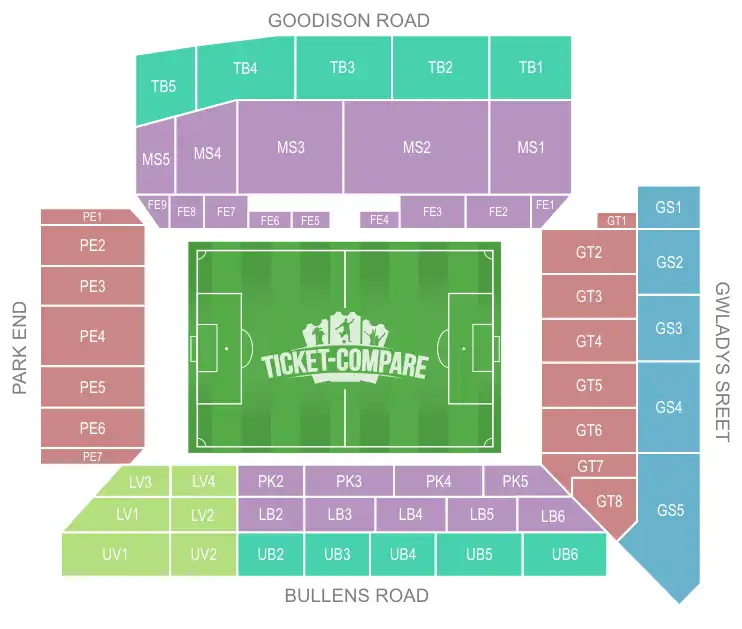Goodison Park Seating Plan at a Glance
| Stand | Approx Capacity | Blocks | Approx Rows | Stand Details |
|---|---|---|---|---|
| Gwladys Street End | 10,611 | GT1-GT8, GS1-GS5 | 50 | 1937 two-tier end, war-scarred, intimate behind-goal views |
| Bullens Road Stand | 10,546 | PK2-PK5, LB2-LB6, UB2-UB6, LV1-LV4, UV1-UV2 | 52 | 1926 Leitch design, TV-style sightlines |
| Park End | 5,750 | PE1-PE7 | 31 | 1994 modern cantilever with unobstructed views |
| Goodison Road Stand | 12,664 | FE1-FE9, MS1-MS5, TB1-TB5 | 54 | 1969–71 main stand, occasional pillar obstructions |
Each of the four stands was completed at a different time, which gives the stadium a charming, irregular feel and creates a very different experience depending on where you get your seat.
However, restricted sightlines, especially towards the back of the older stands, and a lack of premium options has made Goodison Park a little outdated. Everton have been trying to relocate for more than a decade, and construction began on a new stadium at Bramley-Moore Dock in 2021.
The move will be emotional, after more than 130 years at Goodison Park. This stadium has witnessed the great Toffees teams of the 1980s, and some of the finest English players to play the game, from Dixie Dean to Gary Lineker and Wayne Rooney.
The Stands at Goodison Park
Although the seating between the stands is joined up, Goodison Park has four separate stands, each looking very different from the next, and all with an asymmetrical layout, aside from the Sir Philip Carter Park Stand.
Due to the irregular configuration of three of the stands, our row calculations below are based on stand-wide totals, as the row count varies from section to section.
Howard Kendall Gwladys Street End at Goodison Park
Capacity: 10,611
Rows: 50
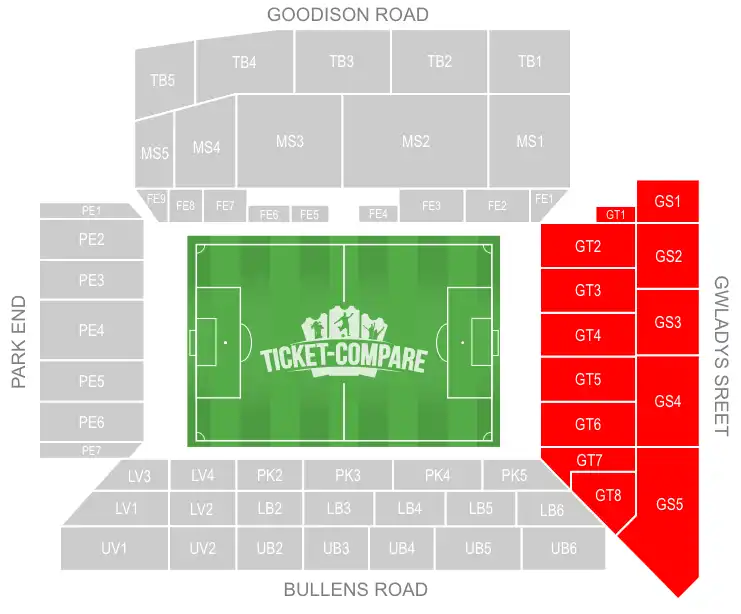
In 2016 this shortside stand was named for the famous former Everton player and manager, Howard Kendall. He won the league with the club in 1970 as a player but also coached the team through the most successful period in its history, winning two league titles, an FA Cup and a Cup Winners’ Cup in an extraordinary period in the mid-1980s.
The Gwladys Street End is on two tiers and has only changed a little since it opened in 1937. It was the last of the original stands to be completed, and at the time, Goodison Park became the first stadium in the country to have multi-tier stands on all four sides of the pitch.
In September 1940 during the Second World War, Goodison Park was hit in a bombing raid, and the Gwladys Street End took the most damage. Even now, you can see the scarring on the brickwork around the turnstiles on this end of the ground.
The Gwladys Street End is the place to go for the most authentic fan experience, especially in the lower tier, behind the goal. The fans here are dyed-in-the-wool Toffees fans, lifting the whole stadium. For a lively atmosphere with better views, try Upper Gwladys (GS). Wherever you are, don’t expect to be able to sit, as most fans are on their feet for the full 90 minutes.
Bullens Road Stand at Goodison Park
Capacity: 10,546
Rows: 52
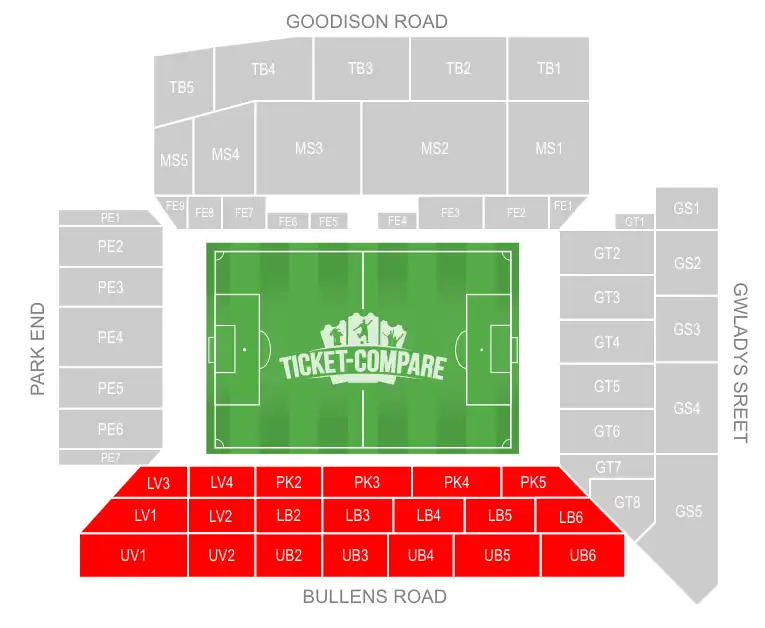
One of the most distinctive features of Goodison Park is the band of steel trusses on the balcony of the Bullens Road Stand. Dating back to a reconstruction in 1926, these criss-crossing supports are an original part of the design by famed stadium architect, Archibald Leitch.
This work gave the Bullens Road Stand three tiers. There’s an Upper Tier and Lower Tier, and below that is an area known as The Paddock. The latter was once a large area with terracing and open to the elements. Of course, things changed over time with a roof in the 1960s, and then seating in the early 1990s following the Hillsborough Disaster.
The Bullens Road Stand hosts the away fans in the southernmost sections (LV1-LV4 and UV1 + UV2). As a longside stand, home to the TV and commentary gantry, this is a great place to be for television-style views. However, as we’ll explain the sightlines can be poor in Upper Bullens unless you find a spot further down, avoiding the roof and pillars if possible.
For atmosphere, this is one of the three noisiest stands in the stadium, maybe just behind the Gwladys Street End. In fact, it could be the liveliest longside stand in the Premier League. With away fans so close, things can get boisterous towards the south end of the stand, especially during derbies.
Sir Philip Carter Park Stand at Goodison Park
Capacity: 5,750
Rows: 31
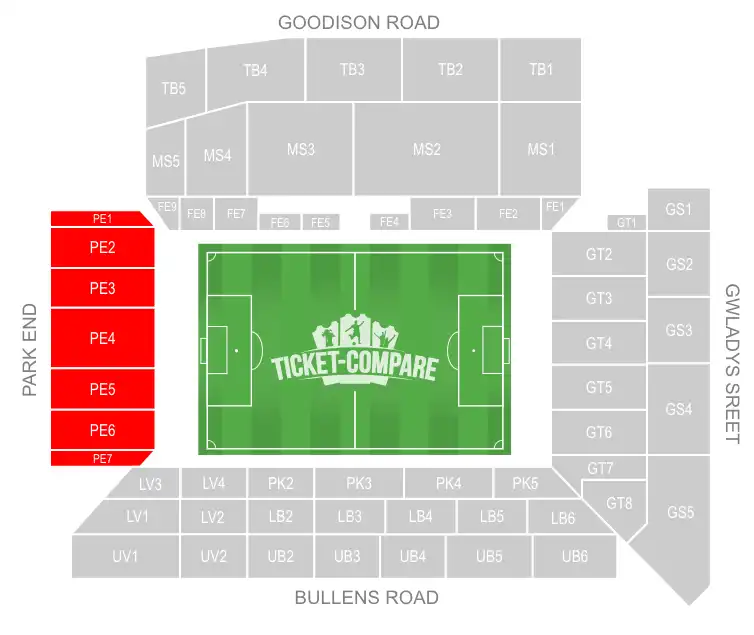
By far the most modern of all of Goodison Park’s stands, the single-tier Park End Stand opened in 1994 and is named for the former chairman who oversaw Everton’s 1980s golden era.
This shortside end points towards Stanley Park and previously had a row of houses built into the stand structure. In fact, players used to live in these homes at the time, including the Everton legend, Dixie Dean. The location makes it the first thing many people see when they approach the ground. The car park is here, along with the club shop and a statue of Dixie Dean.
That was all demolished to make way for the “new” construction, replacing the last standing terrace in the English top flight. Tet terracing was made obsolete by the stadium regulations in the early 1990s following the Hillsborough Disaster in 1989.
With its modern cantilever roof, the Park End Stand has no pylons, and no restricted views. As with the Gwladys Street End and Bullens Road Stand, this is a haven for some of Everton’s more committed and vocal fans. Head towards the bottom of the stand, behind the goal for non-stop singing, and move towards the top for an excellent view of the action.
Being more recent, it’s the least distinctive stand in the ground, but does give you a complete perspective of one of the country’s most unique football stadiums. There are also premium lounges here, like The People’s Club and the Captains’ Table.
Goodison Road Stand (Main Stand) at Goodison Park
Capacity: 12,664
Rows: 54
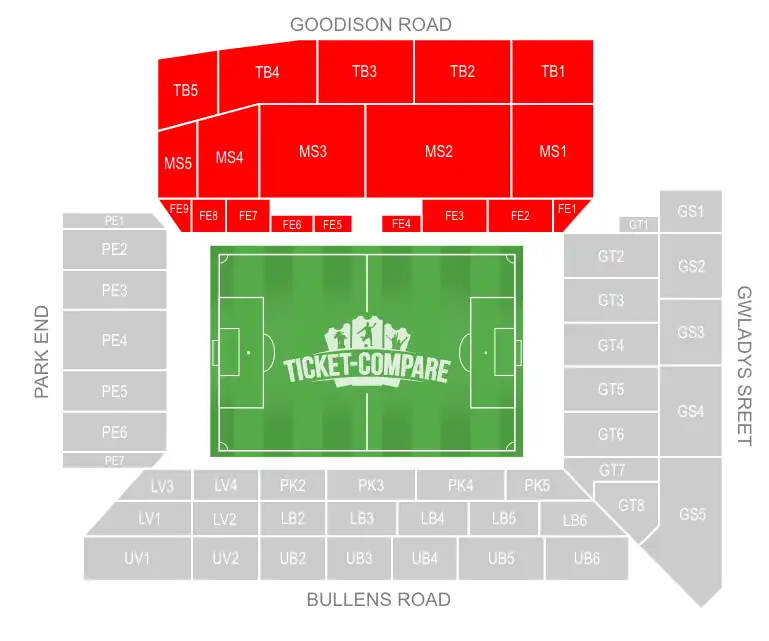
Every historic stadium has a posh stand, and at Goodison Park this is the longside Main Stand, built in phases between 1969 and 1971. There are plenty of interesting features in the Goodison Road Stand, including original 50-year-old seating in the Top Balcony (TB) sections in the Upper Tier.
In keeping with Goodison Park’s asymmetry, this stand is affected by the contours of the namesake road. The layout tapers a little towards the south end, and here the seats are also set at an inward angle, slightly askew from the rest of the stand.
Although there are large pillars that sometimes get in the way, the Goodison Road Stand has the best views in the stadium. The Directors’ Box can be found here, along with most of Goodison Park’s hospitality, as well the main box office, dugouts, dressing rooms and that famous tunnel that emerges from under the stadium.
Partly because of the premium seats, the atmosphere can be a little quieter in the Main Stand, but does improve the further away from the halfway line you go. Also making things a bit calmer is the Family Enclosure (FE), which makes up the lowermost rows in the stand.
Where Should I Sit at Goodison Park?
To Avoid Restricted Views
Unlike most other Premier League stadiums, Goodison Park has several sections where sightlines can be a real problem. This is an issue towards the back of the older tiers, especially Lower Bullens (LB), Upper Bullens (UB), and Lower Gwladys (GT). So best avoid these areas if you want TV-quality views. As a rule, if you’re sitting at the north or east end of the stadium, try to get a seat near the front of the tiers if you want clear sightlines.
For the Best View of the Match
Top Balcony (TB) in the Goodison Road Stand has exceptional views of the action, and the same applies to the Lower Rows of Upper Bullens (UB). You can strike a perfect combination of view and atmosphere by getting a seat towards the penalty area in Top Balcony, where the hardcore Toffees in the Gwladys Street End and Park End Stand have a positive influence on the fans.
For the Best Atmosphere
There’s a clear winner for this category, behind the goals in Lower Gwladys (GT). As we mentioned these sections can have some of the worst views in Goodison Park, and any stadium in the Premier League. On the upside the atmosphere is as good as it gets in English football, with rowdy fans who sing for 90+ minutes and do their best to get on the referee’s back.
For the Premium Experience
Without question the best place is the Goodison Road Stand, where the Directors’ Box and the majority of the stadium premium lounges and boxes can be found. Without question, these are the best seats in the house, with unbroken views, while also being relatively close to the action. As mentioned there are also premium lounges in the newer Park End Stand, with a more affordable price point.
For Family Days Out
Goodison Park has an unusually large family enclosure, lining the pitch for the entirety of the Main Stand. The views here are interesting, because you can’t get any closer to the pitch. However, some kids may struggle to see all of the action on the lowermost rows because these seats are significantly below pitch level.
Accessibility
Another reason Goodison Park is outdated is because of an absence of accessibility. This stadium often ranks among the worst in the Premier League, particularly when it comes to accessible entrances and lifts. However, 23 accessible toilets is about average for the league.
In terms of spaces, there are a total of 172 in the ground, 104 of which are pitch-side, with 68 elevated. These are dispersed across the Park End Stand, Bullens Road Stand (Paddock) and the Gwladys Street End.
| Section | Blocks | Block Count |
|---|---|---|
| Away | LV1, LV2, LV3, LV4, UV1, UV2 LV1, LV2, LV3 | 6 |
| Longside Lower Tier | FE1, FE2, FE3, FE4, FE5, FE6, FE7, FE8, FE9, LB2, LB3, LB4, LB5, LB6, MS1, MS2, MS3, MS4, MS5, PK2, PK3, PK4, PK5 FE1, FE2, FE3 | 23 |
| Longside Upper Tier | TB1, TB2, TB3, TB4, TB5, UB2, UB3, UB4, UB5, UB6 TB1, TB2, TB3 | 10 |
| Shortside Lower Tier | GT1, GT2, GT3, GT4, GT5, GT6, GT7, GT8, PE1, PE2, PE3, PE4, PE5, PE6, PE7 GT1, GT2, GT3 | 15 |
| Shortside Upper Tier | GS1, GS2, GS3, GS4, GS5 GS1, GS2, GS3 | 5 |
